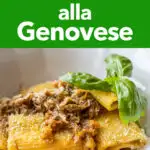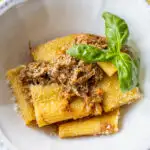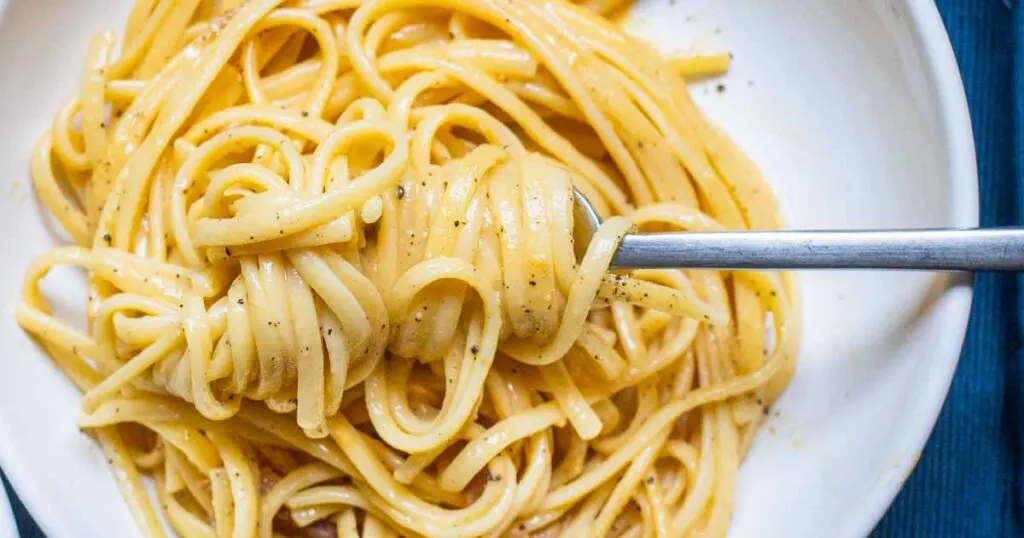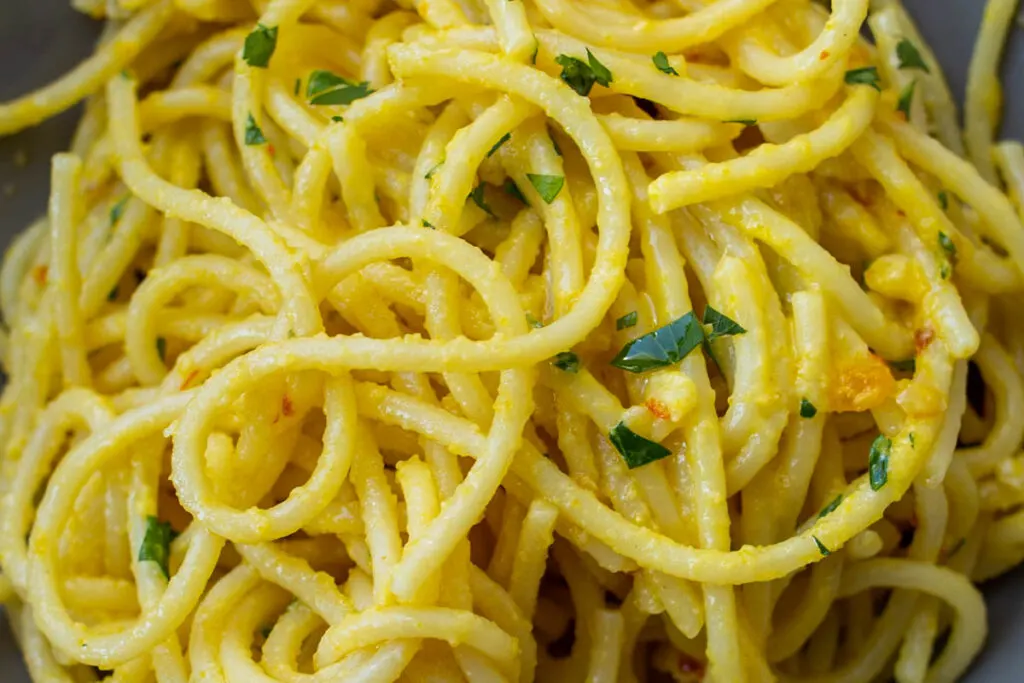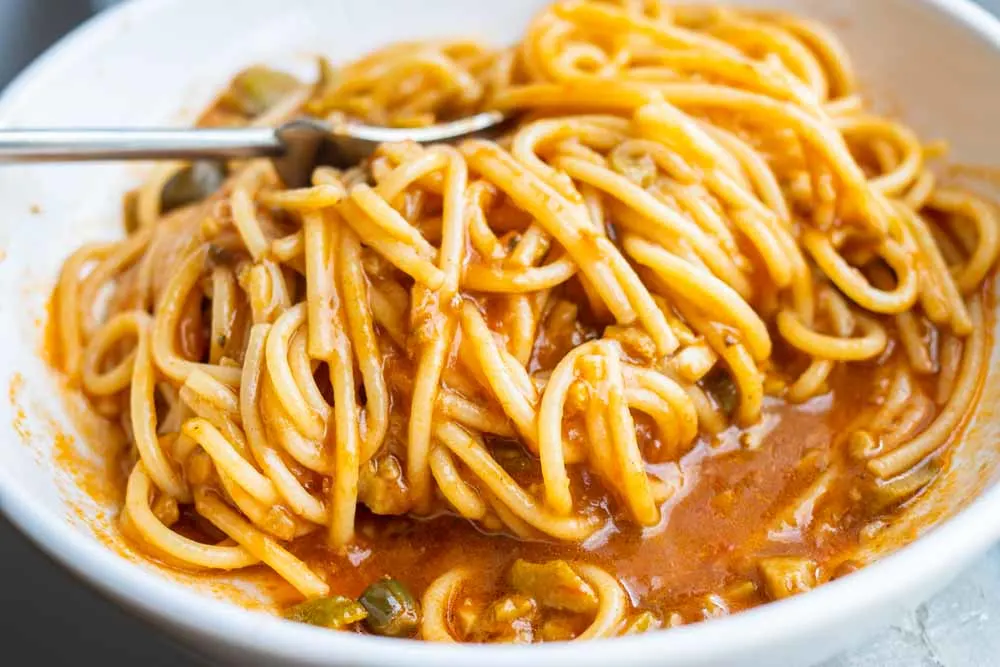Pasta alla Genovese screams Naples just as much as pizza and sfogliatella do. Topped with a simple sauce that’s loaded with caramelized onion and stewed, the savory pasta dish epitomizes Italian rusticity.

As a celebrity chef we watched when we were kids used to say… Pasta alla Genovese “is the food of Grandma.”
When we close our eyes, we picture a Neapolitan grandmother trying not to cry as she slaves over a pile of onions while cooking Pasta alla Genovese. We also picture her feeding the resulting mounds of stewed meat and onions generously slathered over hollow tubes of hearty paccheri to her huge, hungry family.
You may be wondering why a dish referring to Genoa is from Naples. After all, the two great Italian food cities are more than 400 miles apart. We wondered the same thing ourselves.
Genovese And Naples

Neapolitans’ love for great pizza is obvious but many in the wonderfully crazy Campanian city hide a secret love for a sauce that, over hundreds of years, has become as synonymous with the town as graffiti covered buildings and nearby Mount Vesuvius.
It’s practically impossible to find a trattoria in Naples that doesn’t list Pasta Genovese on its menu among other Naples food favorites. But it’s not just at trattorias…
We’ve enjoyed the meaty sauce at legendary Pizzeria Concettina ai Tre Santi. The pizzeria was so proud of its Genovese that it served extra sauce in a copper pot to go with our frittatina starter. In other words, Neapolitans are as serious about their Genovese sauce as Emilians are about their Ragu.
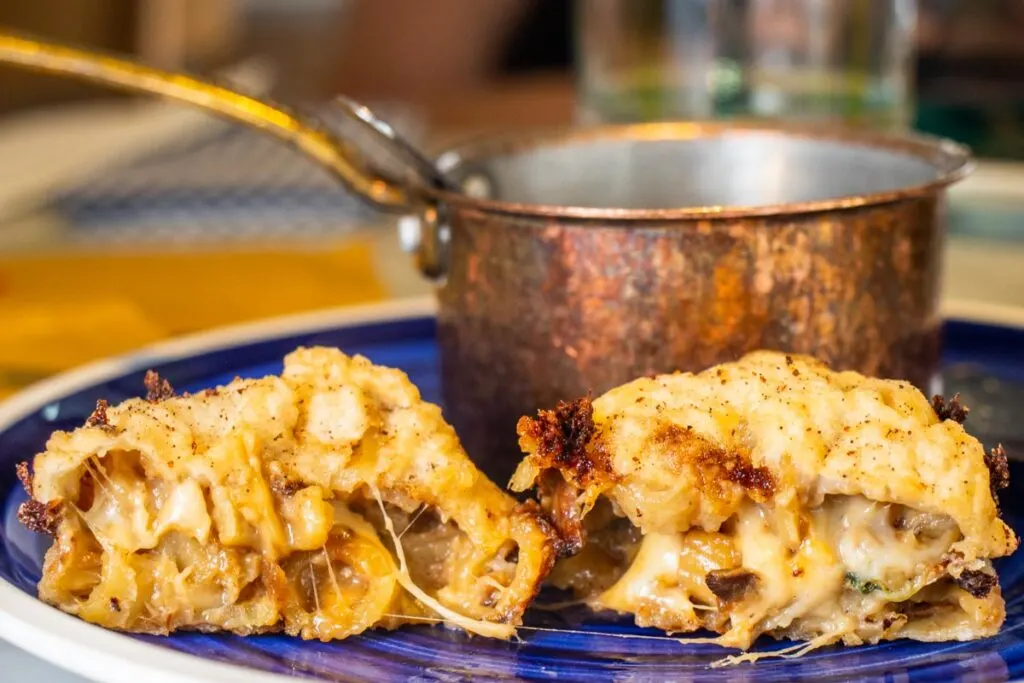
This connection may seem odd considering that the name “Genovese” evokes images of pesto and Christopher Columbus instead of volcanoes and Pompeii. So why does Naples’ most famous pasta dish include the name of a Northern Italian city?
Some believe that Genoese settlers brought Pasta alla Genovese to Naples; however, this story doesn’t make sense since there’s no evidence of this dish in Genoa’s history or cuisine. Others speculate that the sauce gained its fame from either a Genoese chef or a restaurant on Via Genova or a restaurant named after Genoa.
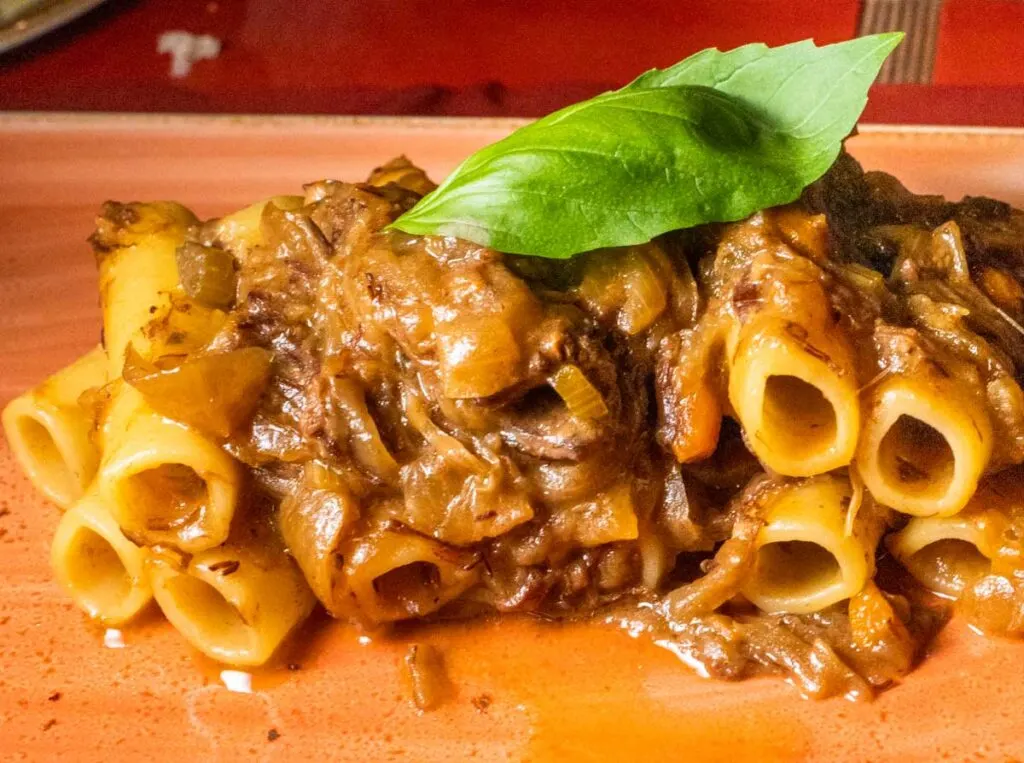
Additional origin stories attribute the dish’s name to a style of sauce making that diverts from tomato-based Neapolitan Ragu. In other words, nobody really knows the answer to the question.
What we do know is that the dish’s combination of onions, beef and mirepoix produces one of the great sauces of Italy. At the end of the day, that’s what really matters.
What Is Pasta Alla Genovese?
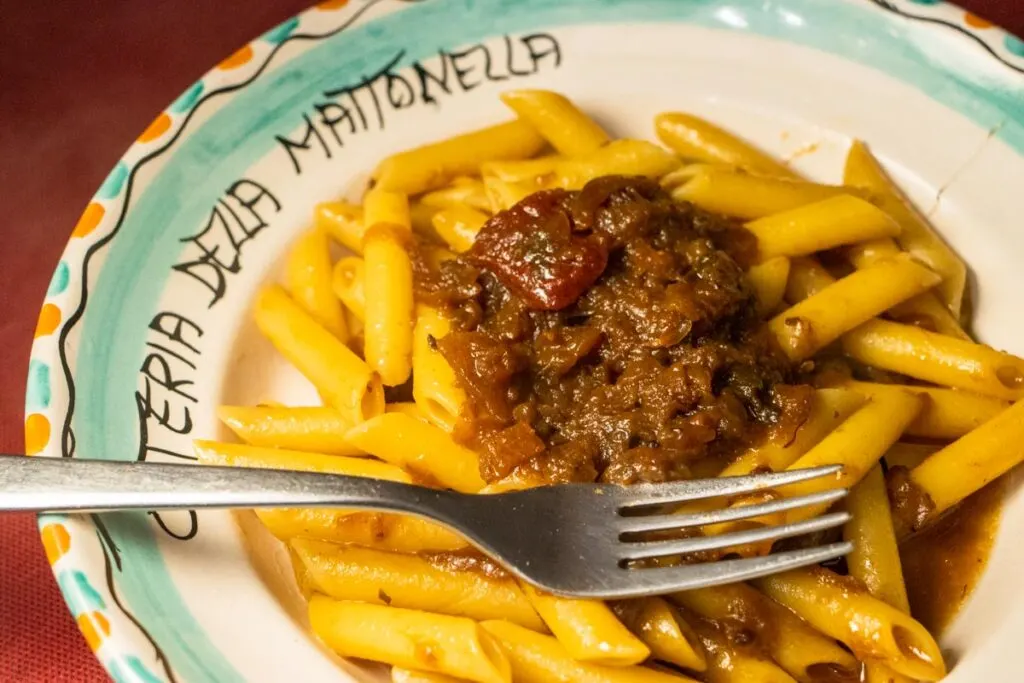
Usually involving an enormous pot of sauce big enough to feed over 10 people, Pasta alla Genovese is the kind of dish eaten at big Sunday dinners at ‘Nonna’s house’. But what is it?
Imagine a beef stew, but instead of cooking the beef until it’s about to fall apart, you braise stewing meat until it totally falls apart. Oh. And the onions. Also imagine a mountain of onions that cook into buttery, sweet, caramelized oblivion.
Genovese sauce is an Italian Ragu with caramelized onions that’s reminds us of French Onion Soup. You could almost call the dish French Onion Beef Ragu.
Ingredients
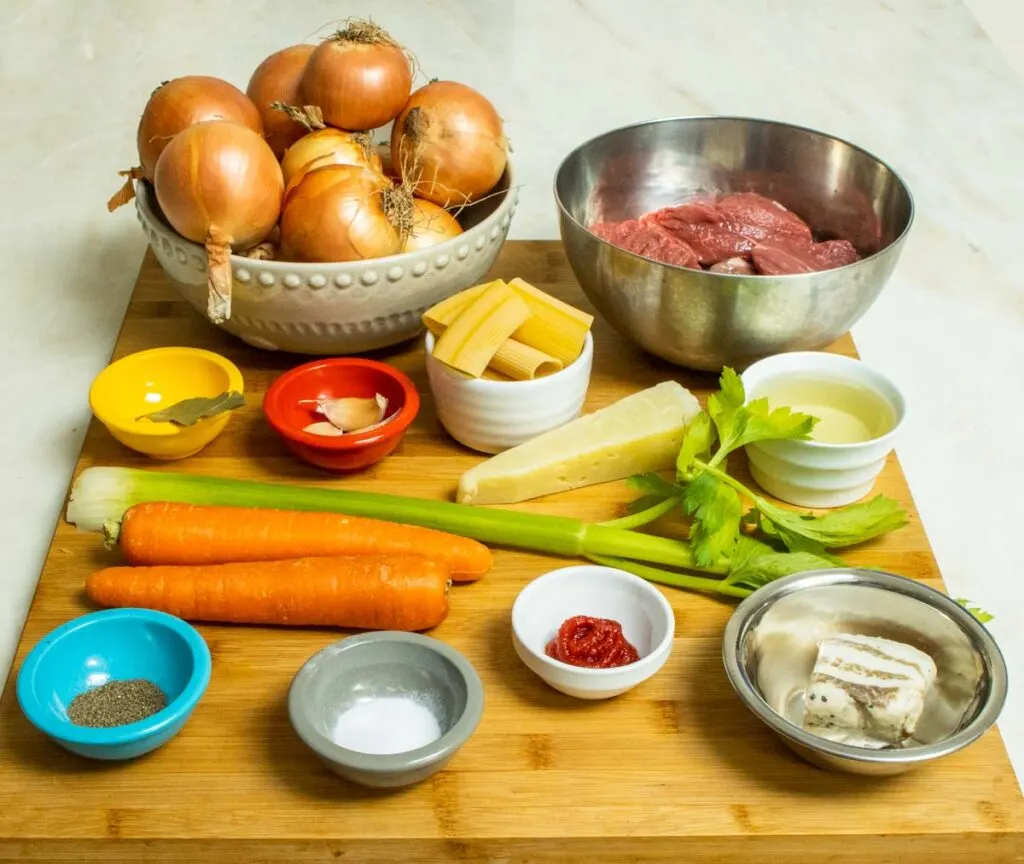
We use the following ingredients in our Pasta alla Genovese recipe:
Our recipe calls for a generous amount of beef and an even more generous amount of onions. Great cooking is a matter of ratios and we credit the folks at Serious Eats for establishing a ratio of two parts onion to one part beef that works.
The amount of carrot and celery in the sauce is a fairly standard – one celery rib and two carrots. However, we recommend just using one carrot to temper the intense sweetness provided the onions. Speaking of onions…
Onions
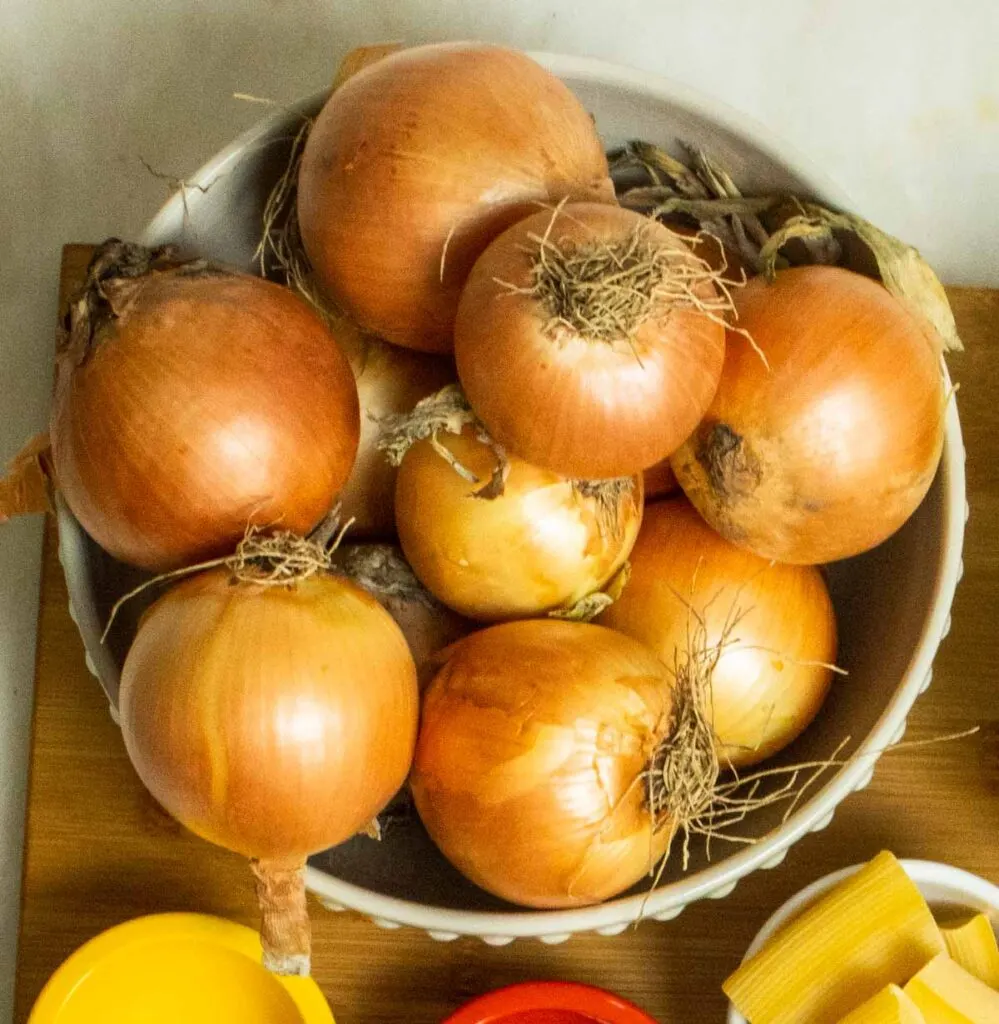
Yes, our recipe requires a s*** ton of onions – about 4 to 5 pounds. This amount may seem intimidating but, with the correct technique (see our instructions – below) and a good sharp knife, you can quickly slice the onions without activating your tear ducts.
Beef
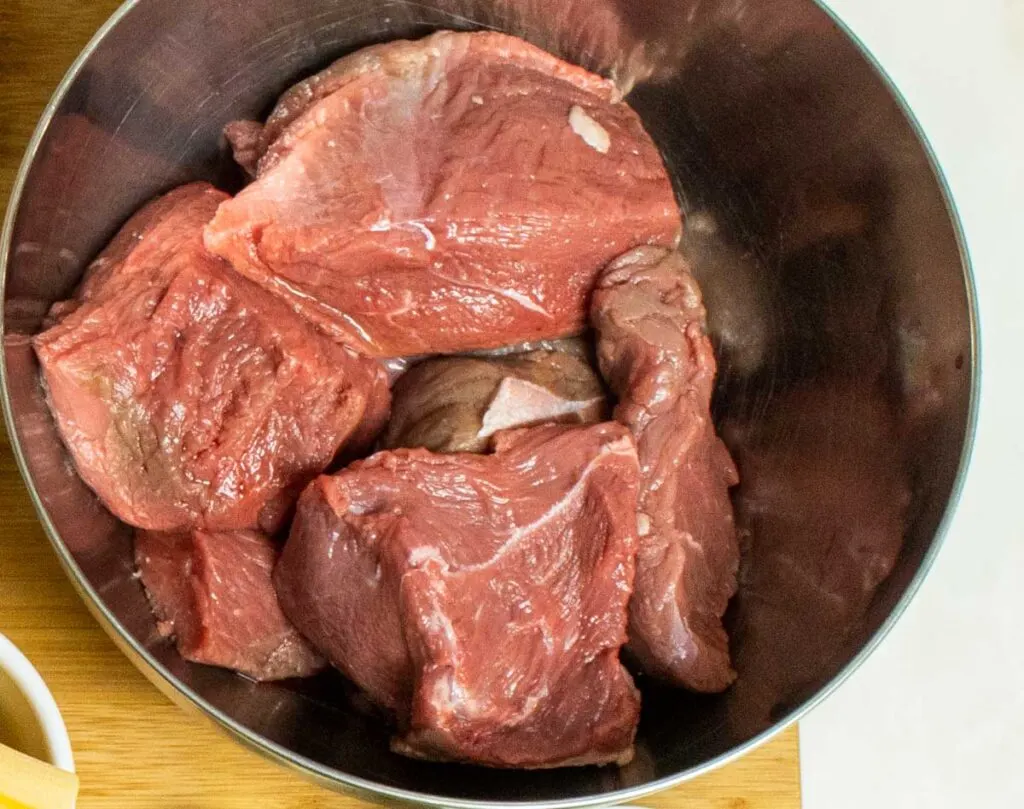
We live in Portugal where lean, grass fed beef is commonplace as opposed to the fatty marbled product typically sold in the USA. Despite our concerns that the meat would be tough, after hours of stewing, our fears were allayed when our stew meat broke down, melting cohesively with our caramelized onions.
Assuming that you live in the USA, we recommend chuck roast, which is commonly found at any supermarket, for this recipe. You’ll need to cut the beef into 3” square chunks. You’ll also want to remove any silver skin from the beef.
Because we use super salty salt pork in the recipe, we decided not to season our beef before cooking it. The beef fell apart so thoroughly after hours of stewing that it was possible to season the sauce to taste with salt and pepper at the end of cooking and still get even seasoning coverage.
Aromatics, Mirepoix And Tomato Paste
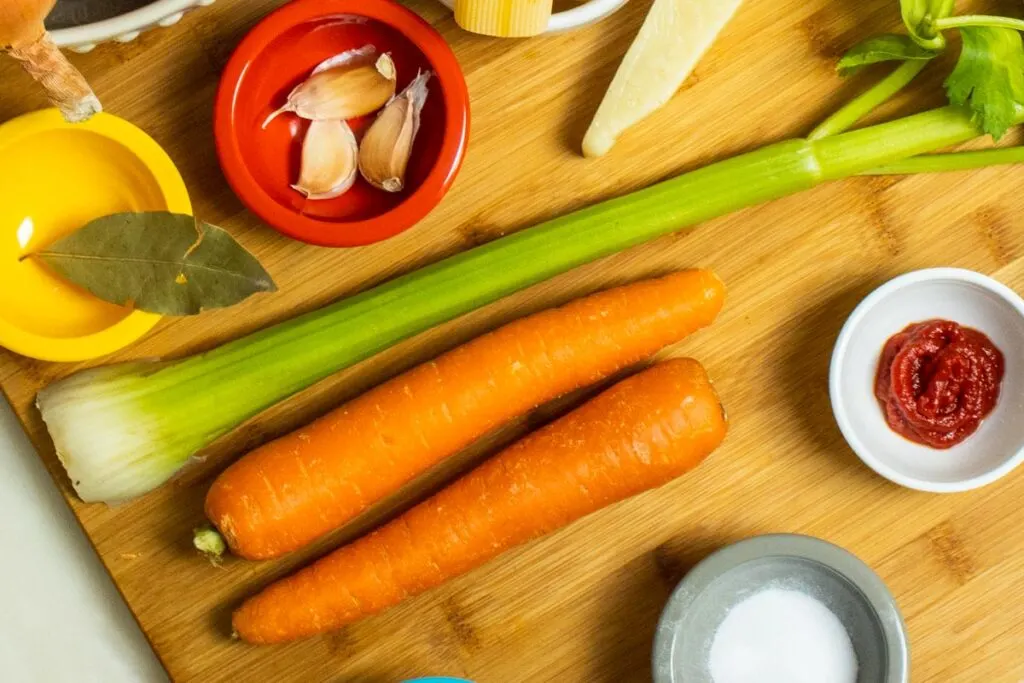
We add bay leaf because that’s what Grandma would do. And by Grandma, we mean Nonna.
We add tomato paste in order to provide a layer of backbone to the sauce and to temper the sweetness of the onion. In other words, in addition to the beef, tomato paste adds a layer of umami.
We also add carrots and celery to achieve a flavorful dimension in the sauce. We originally added two carrots but we later reduced the amount of carrot to one in order to give the sauce a more savory flavor profile.
White Wine
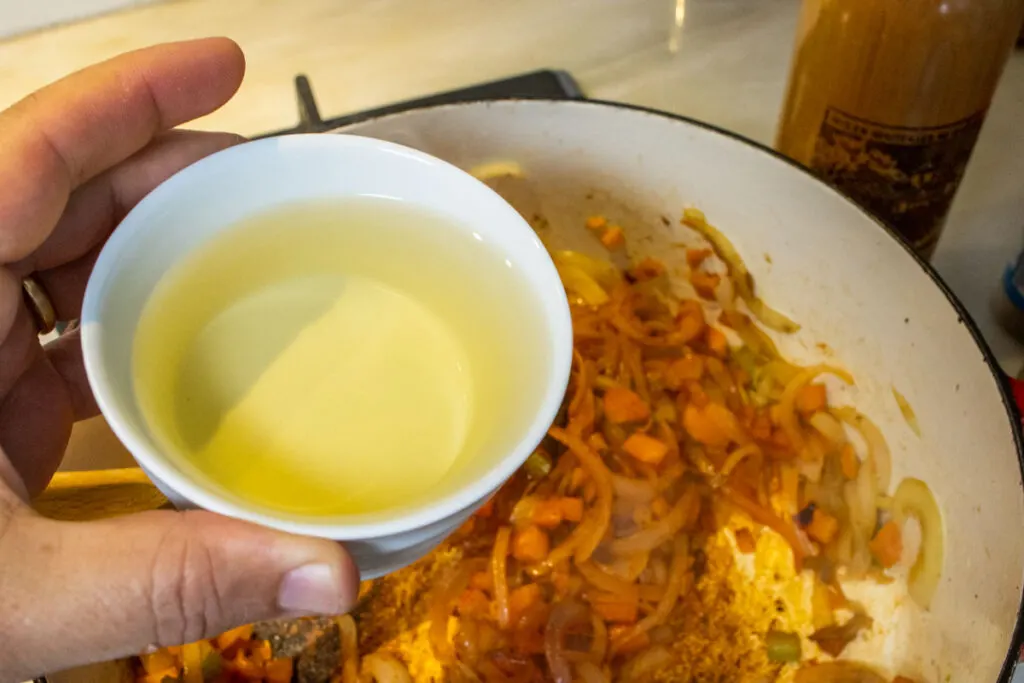
We recommend using a generous amount of dry white wine.
The wine fills a number of purposes. First, it deglazes the brown bits on the bottom of the pot when you brown the beef. Second, it will provides a dose of acidity and zip to balance the sweetness of the onion.
As far as the wine to use – we recommend any white wine as long as it’s dry and drinkable. Yes. Yellowtail or Gallo will do if that’s what you have in your pantry.
Fat
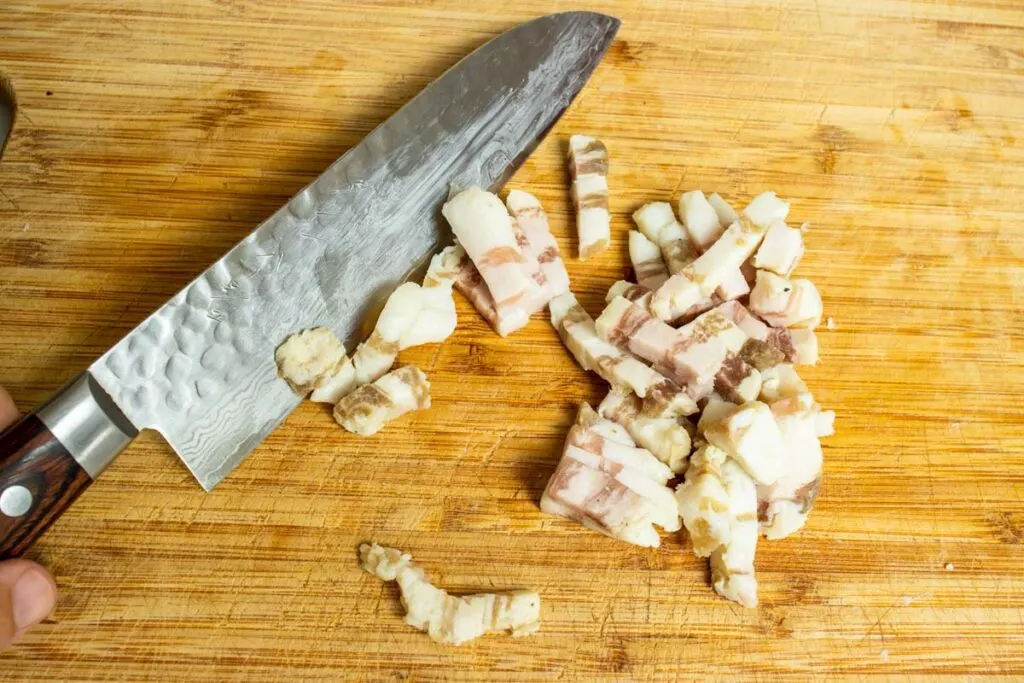
To begin your saute, you can use any fat that suits your needs. Options include pancetta, salt pork and even guanciale.
In Campania, cooks use a back fat similar to Tuscan Lardo called Strutto. You can use vegetable oil but be aware that rendering pork fat will give you more flavor.
Hey, you could even use American bacon but, for better or worse, your Genovese sauce could end up with a slight smokey flavor. Campanians may roll their eyes but, that being said, your sauce will still taste good.
Seasoning
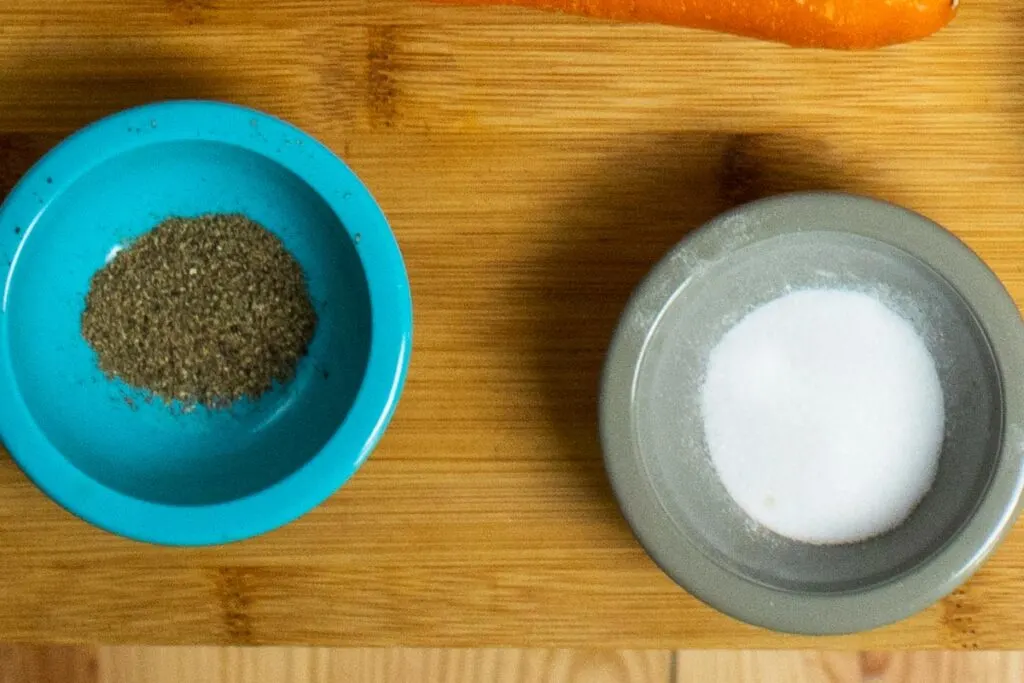
In addition to a bay leaf, we also add salt and pepper to season the sauce at the end. We find this adequate due to the bracing saltiness of the recipe’s salt pork. Season to taste if you add less salty pancetta or guanciale.
Pasta
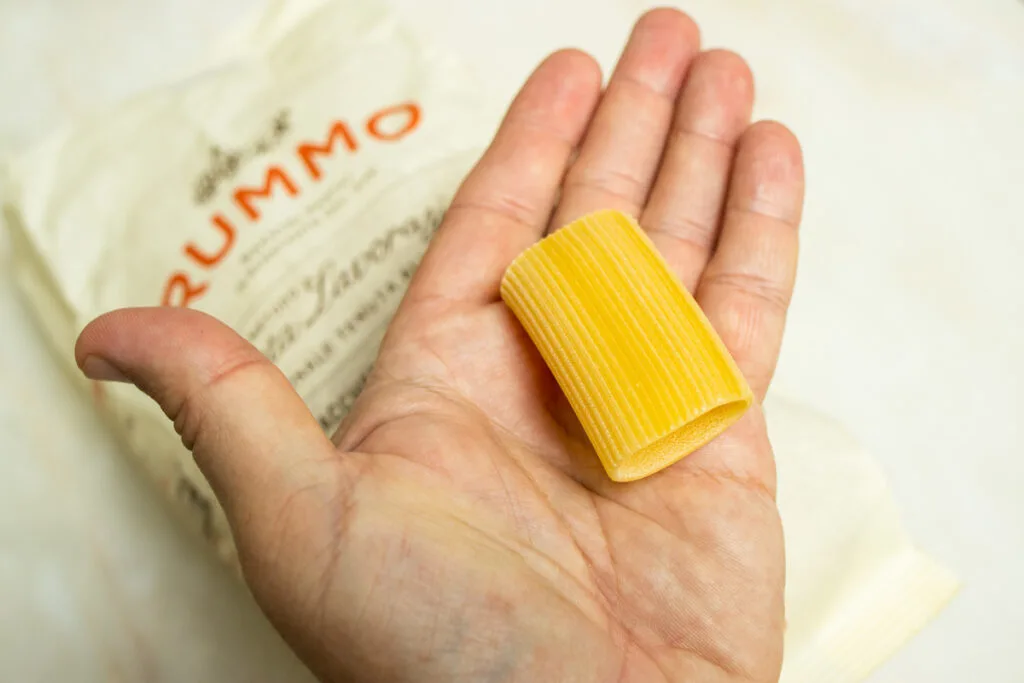
Genovese sauce is no Mild Marvin. Accordingly, wimpy pasta like spaghetti or fettuccine won’t suffice. Instead, Genovese sauce requires a big toothsome, hearty pasta like paccheri or rigatoni.
Neapolitan cooks often use ridge-free paccheri when they cook Pasta alla Genovese. While we would love to find that kind of pasta, we were thrilled to find ridged Paccheri Rigate produced by Rummo, one of Italy’s top pasta producers, here in Lisbon.
The brawn of this pasta stands up to Genovese sauce like an antique vespa responds to Napoli’s cobblestone alleys.
How To Make Pasta Alla Genovese
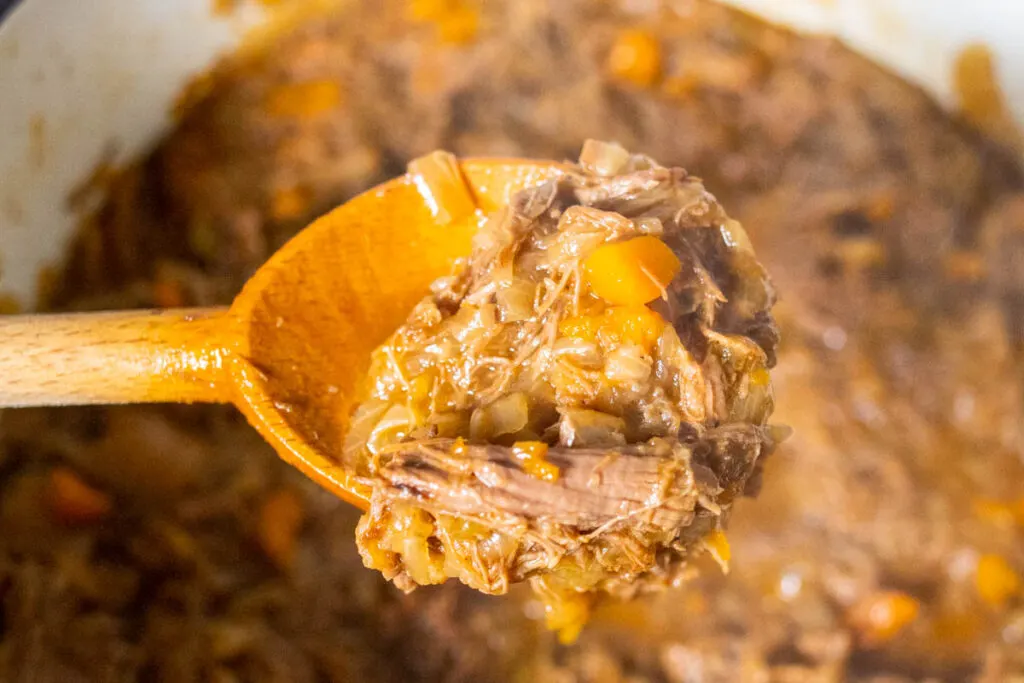
Pasta alla Genovese is one of those dishes that requires a bit of work up front. But, once you’ve prepped your ingredients, cooking this sauce is easy.
Cooking this dish will teach you how to dispatch your ingredients efficiently. You’ll also learn to prep while you begin the process of cooking.
Pro Tip
We recommend using a large heavy bottomed pot Dutch Oven when you cook this recipe at home.
Rendering The Fat
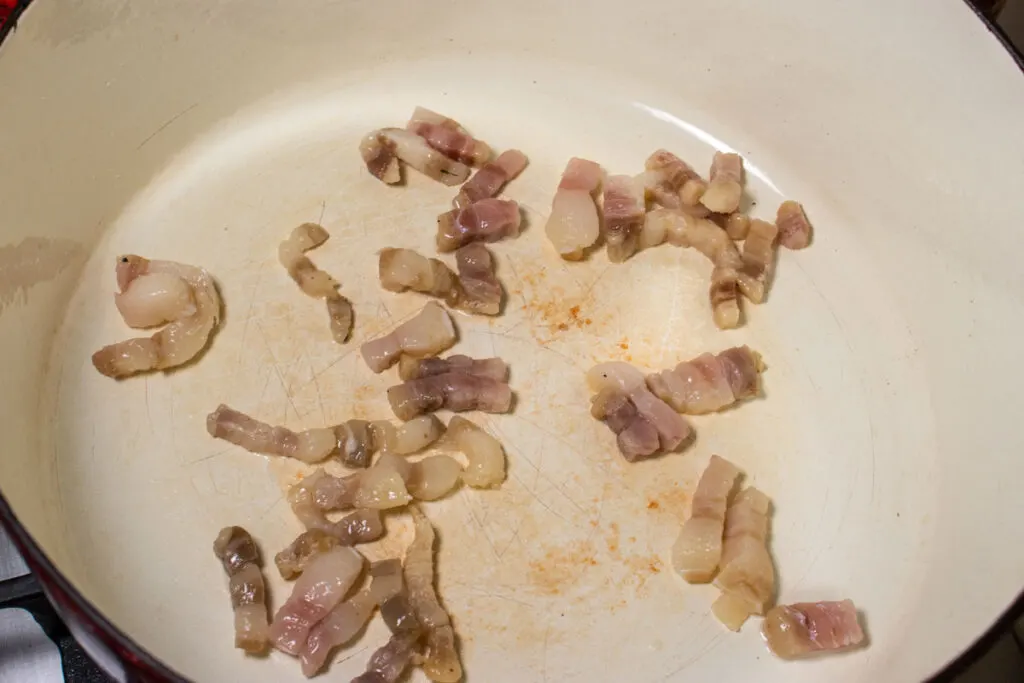
Start by rendering the fat from your salt pork, pancetta or bacon. If you decide to use vegetable oil you can skip this step.
Place your fat in the cold pan on a medium flame. Once the fat is rendered (when you see at least a tablespoon of liquid fat in the pot), remove the pork from the bottom of the pot.
Preparing The Beef
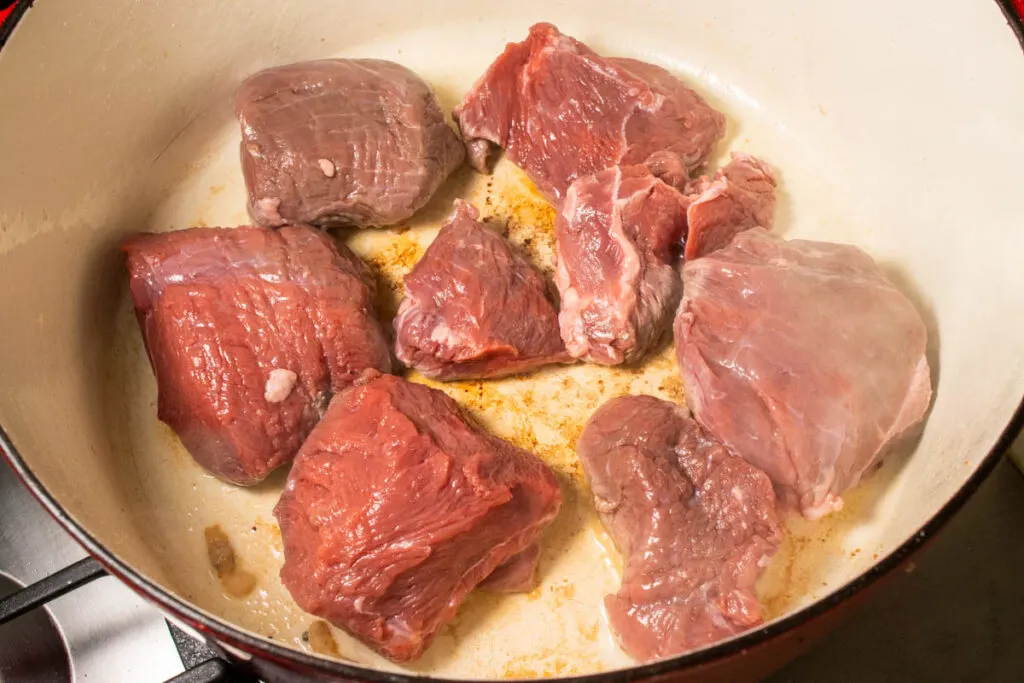
Cut the beef into large chunks – about 3” by 3”. Also, cut off any silver skin off the beef.
Preparing The Mirepoix
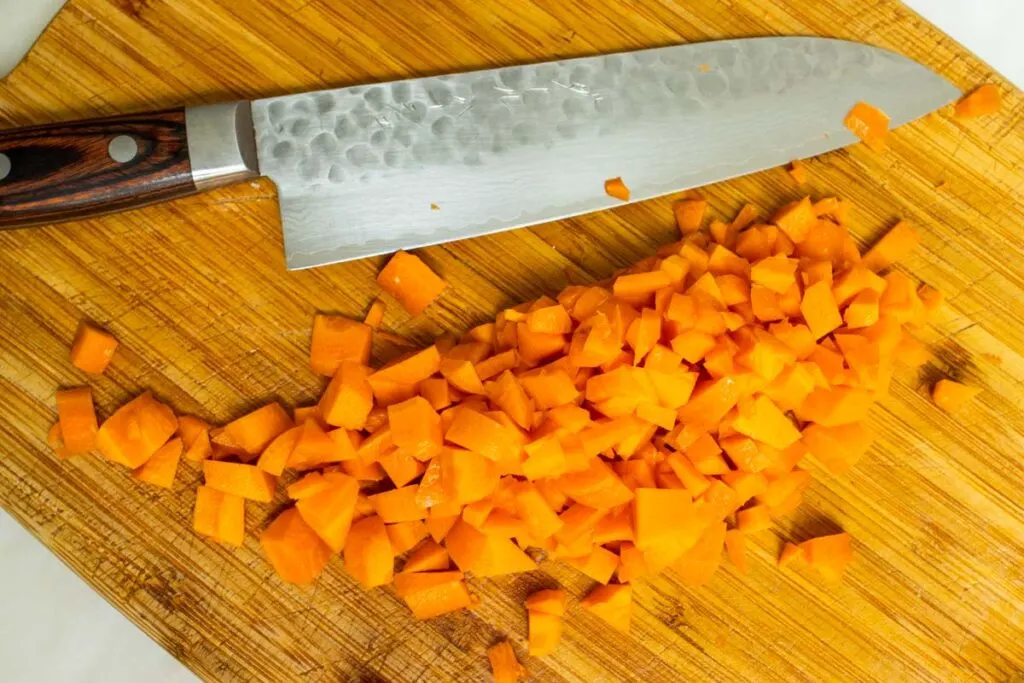
Dice the carrots and celery into 1/2″ pieces.
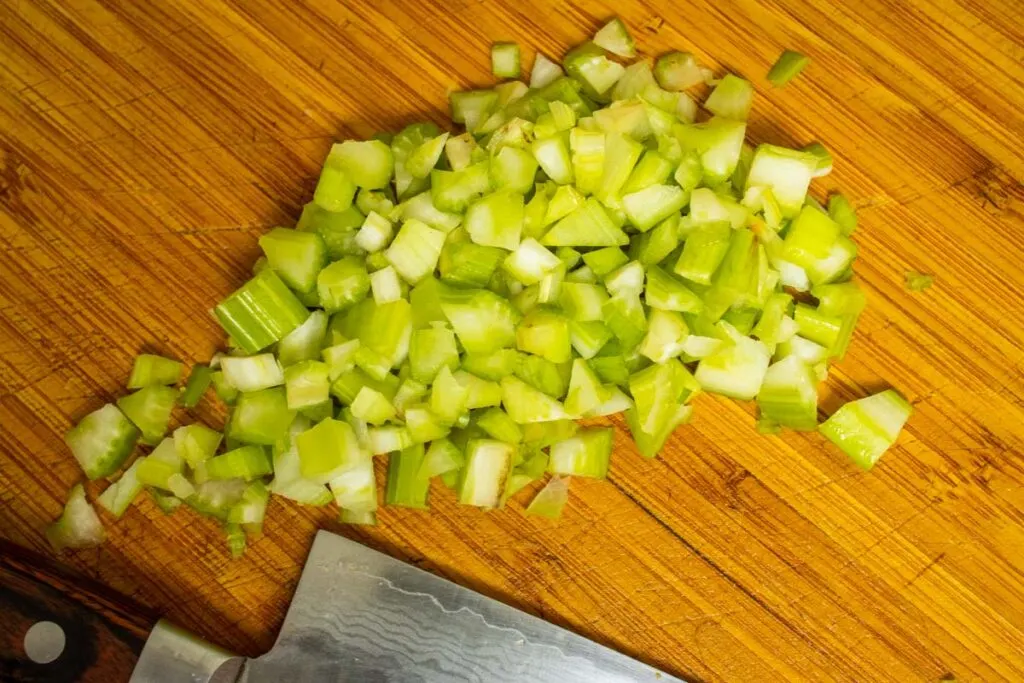
Since this is a homestyle, rustic preparation, the dice doesn’t have to be exact.
Slicing The Onions
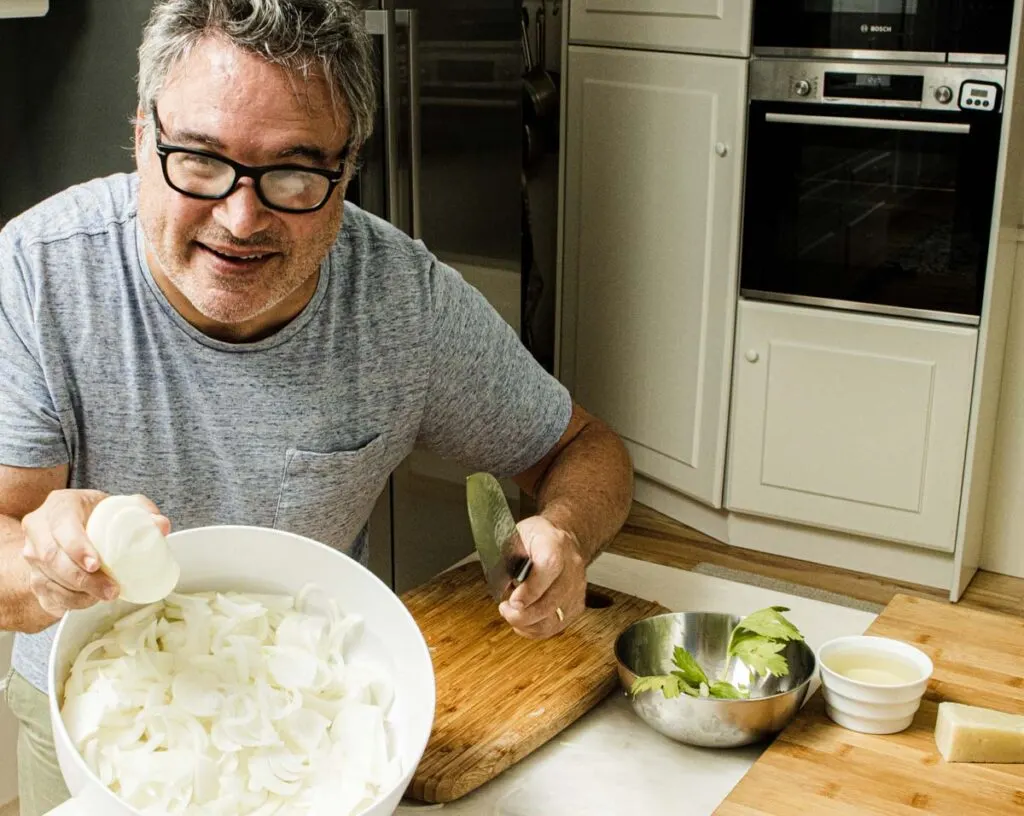
Let’s be real. Four to five pounds of sliced onions is a tremendous amount of onion. But it’s what you need to make Genovese sauce at home.
Slicing this many onions may seem like an intimidating job but, if you follow the following steps and use a sharp knife (very important), you’ll make quick work of the task without a lot of tears. In fact, you may even find the task to be fun and improve your cheffing skills in the process.
Start by cutting the poles off the onions. The sulphur compounds in the onions that make people cry are mainly found in the dark root end. You may feel a little watery during this step but doing this will minimize your exposure to the roots and the resultant tears.
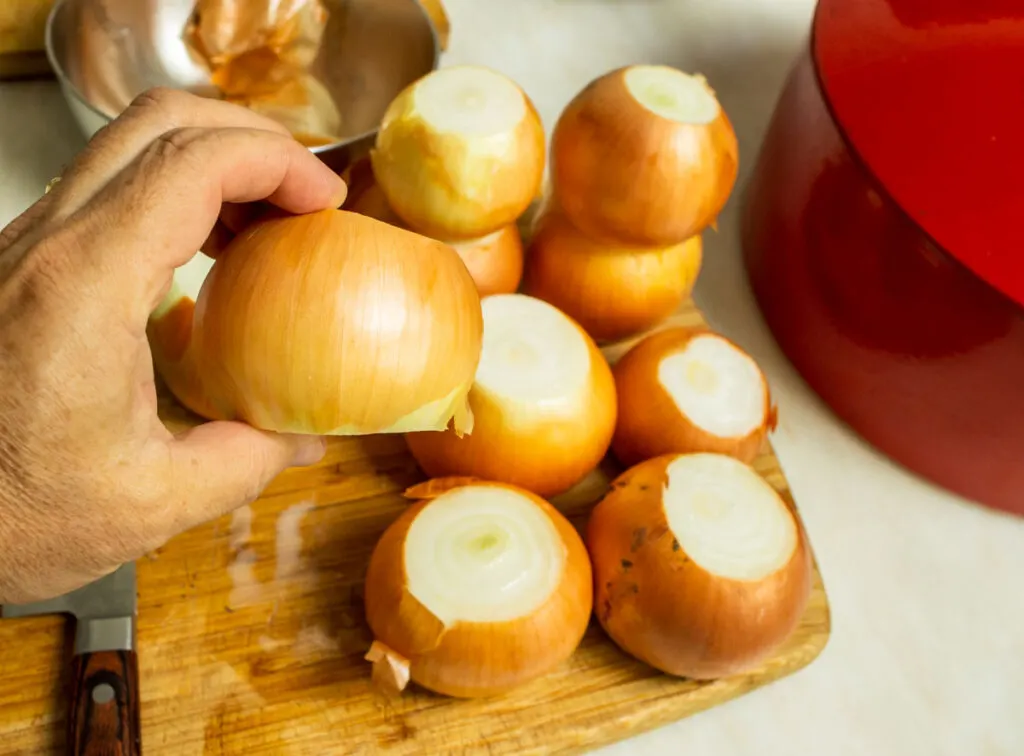
Next, cut your de-poled onions in half down the axis. You can then peel the leathery skin off the outside of the onion halves.
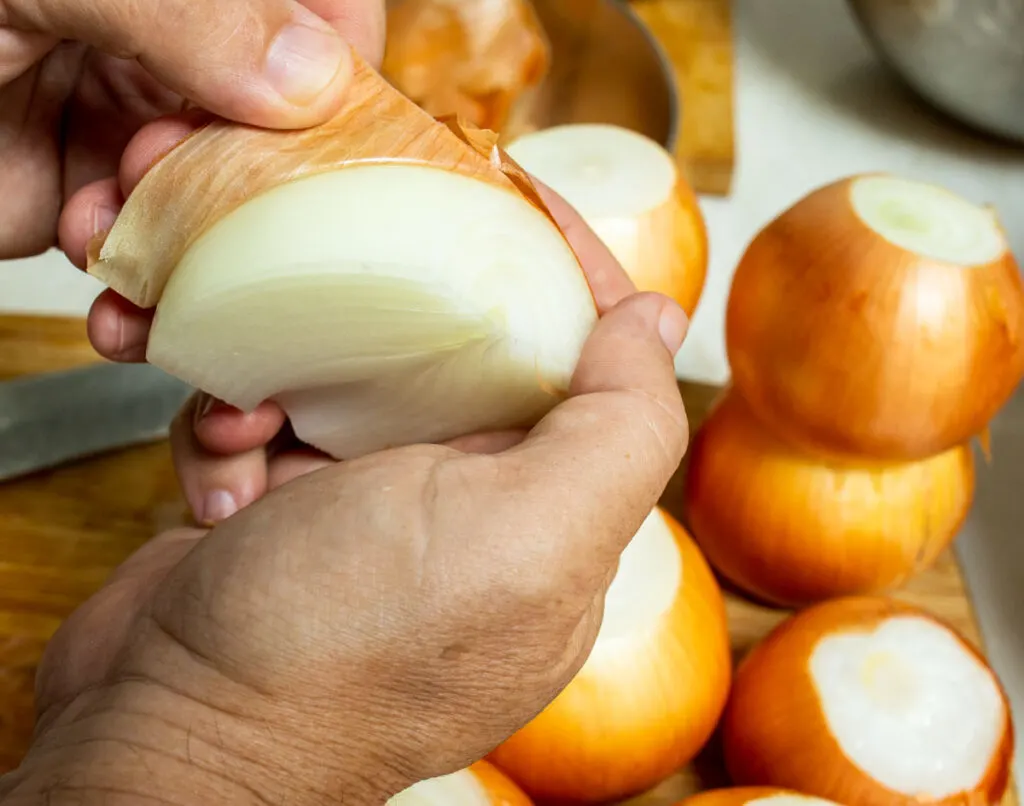
Next, slice the onions from pole to pole. This step may seem counterintuitive to the way you usually dice onions; however, this method is proper in this recipe.
Cup your hand, using the middle knuckles of your fingers as a guide to slowly drift across the onion. It’s important to keep your thumb behind your fingers.
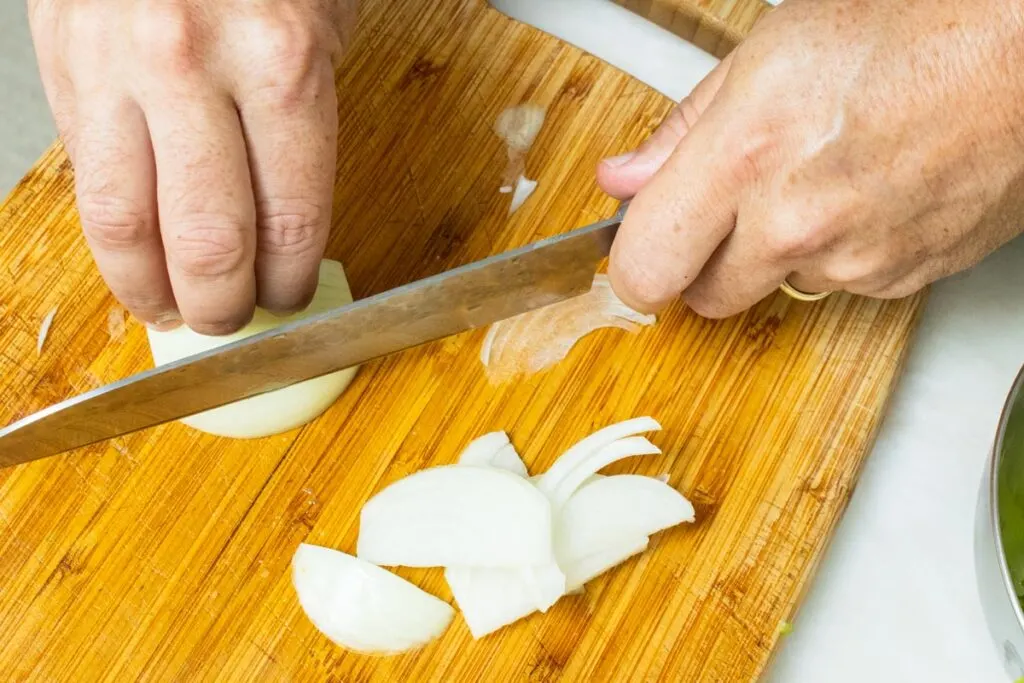
If you’ve never sliced onions like this before, start slowly. You can pick up speed once you feel comfortable.
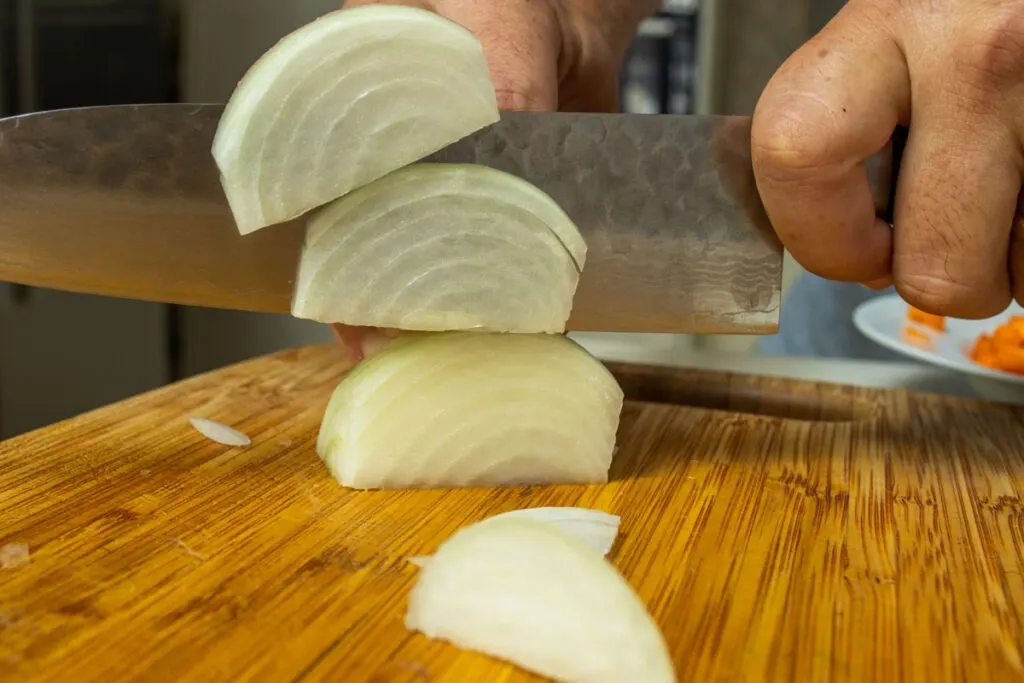
Safety Tip
Your eyes are so your most important safety tool in the kitchen. Always keep your eyes on your knife when you’re cutting food.
Browning The Beef
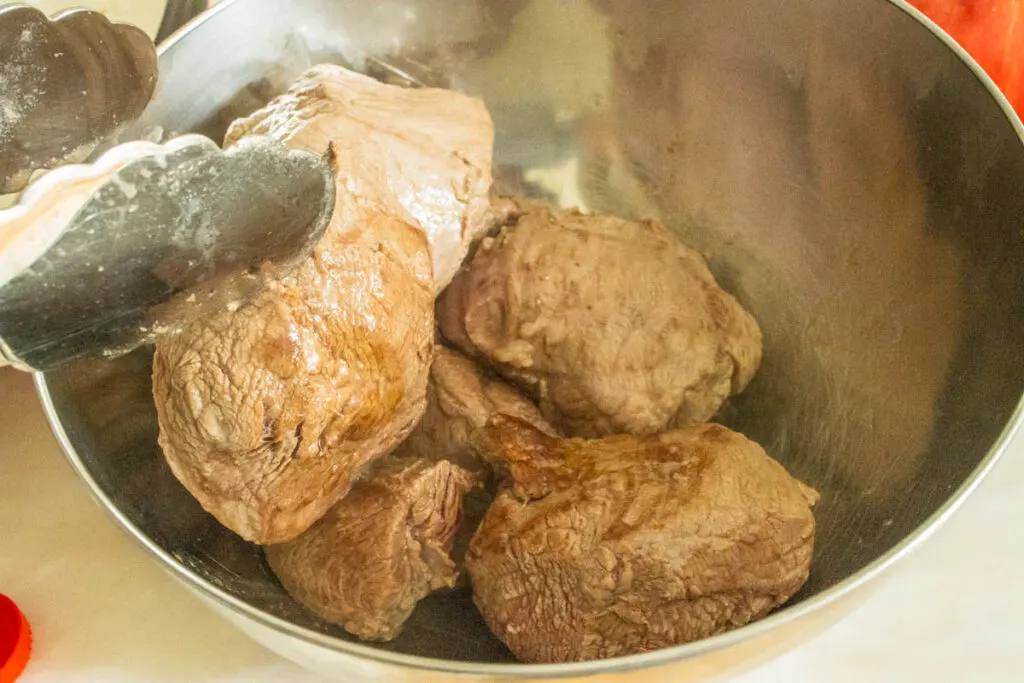
The fat should render from the pork while you cut your de-poled onions in half down the axis.
Remove the pork from the pot. Raise the fire to high, add the beef and cook each side until brown. Once brown, remove the beef from the pot.
Preparing the Mirepoix
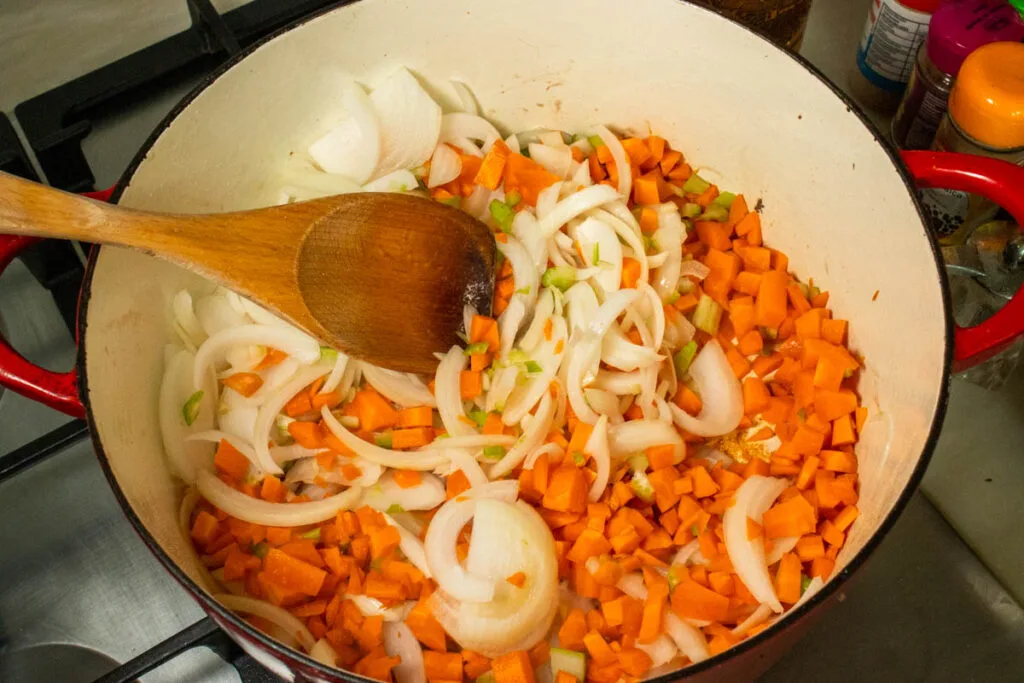
At this point, take a couple handfuls of onions plus with the celery and carrots as well as the bay leaf and drop them all in the hot pot to begin your sauté.
The liquid from the onions should liberate any brown bits from the bottom of the pot. You’ll want to cook the mirepoix until the onions are translucent.
Add the garlic to the pot and cook until fragrant, approximately one minute. Pour in the white wine and rub a wooden spoon on the bottom of the pot, scraping up any remaining brown bits on the bottom of the pot.
Adding The Beef And The Rest Of The Onions
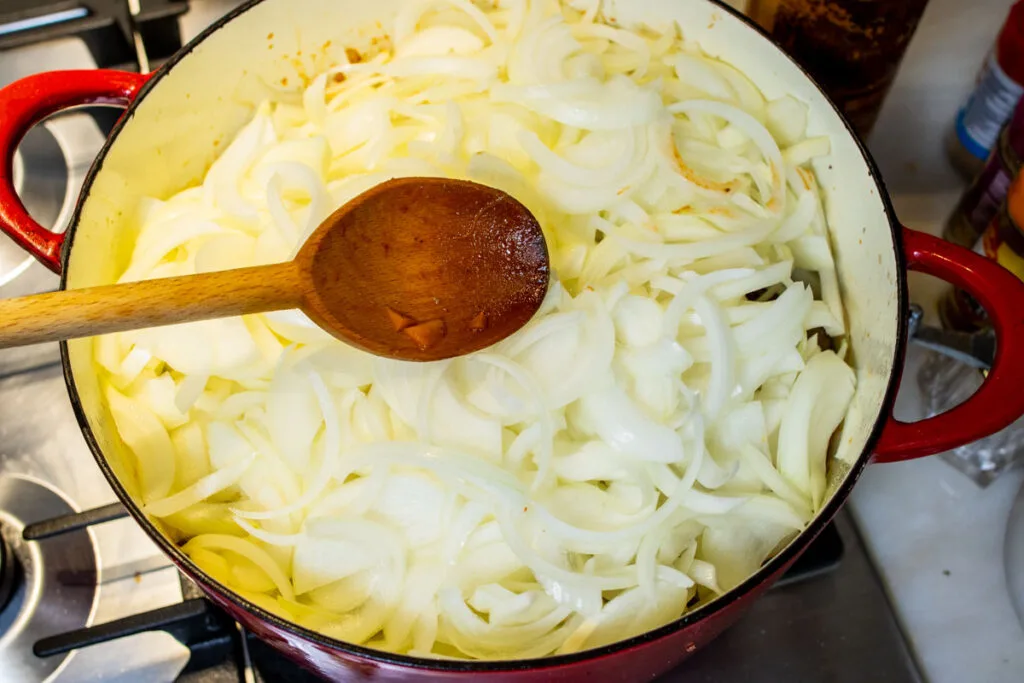
Once you’ve cut all the onions, add the beef back into the pot and cover the pot with the remainder of the onions. Cover the pan, turn the heat up to medium high and cook for 30 minutes. We learned this technique from Chef John from Food Wishes and it works.
After 30 minutes, the liquid should draw out of the meat and onions, providing a braising solution. It may seem like there are too many onions for the pot but, as the onions cook, the liquid cooks out of the onions and the onions caramelize.
Seeing the massive amount of onions cook down is one of the greatest parts of making this sauce. It’s a beautiful thing.
Cooking The Genovese Sauce
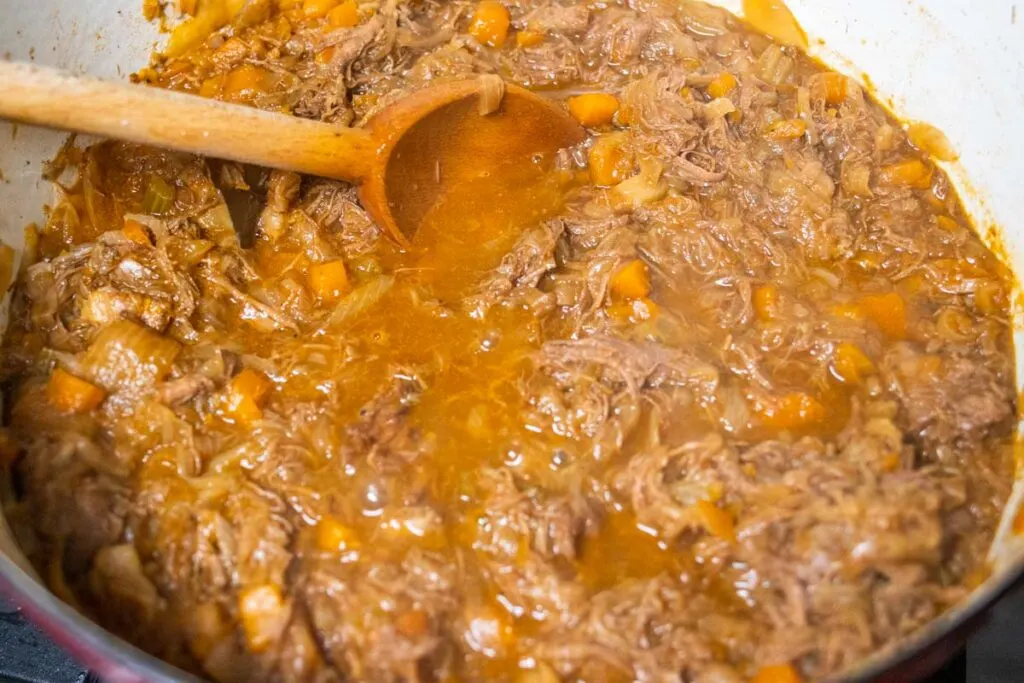
After 30 minutes of cooking, turn your fire down to the lowest setting and cook, stirring about every thirty minutes, until the beef has totally broken down, falls apart and become part of the cohesive sauce, This will take about five hours.
Once the sauce has broken down, taste and season it with salt and pepper to your liking.
Serving
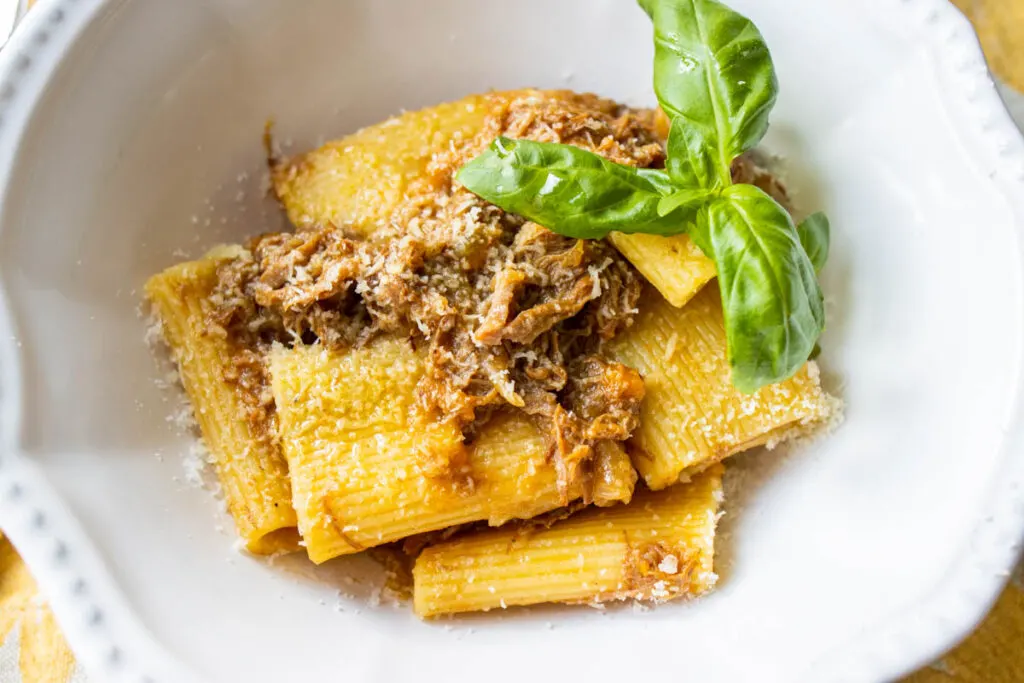
Mix the sauce with your cooked pasta. You can serve it with your choice of garnish.
We like to use basil but you could easily use parsley or the leaves from your celery stalk. Since this is a Southern Italian dish, we also add grated Pecorino Romano cheese on top before serving and eating. You can alternatively use Parmigiano-Reggiano if that’s what you have at home.
Did you make this pasta dish? If so, please rate the recipe below.
Pasta alla Genovese Recipe
Ingredients
- 4 to 5 pounds yellow onions (sliced)
- 2 pounds beef chuck (silver skin removed and cut into 3" cubes)
- 1 carrot (medium)
- 1 celery rib
- 3 garlic cloves (finely chopped)
- 1 bay leaf
- 8 ounces salt pork (guanciale or pancetta)
- 2 tablespoons tomato paste
- ¾ cup white wine
- salt (to taste)
- black pepper (to taste)
- 2 pounds pasta
- Pecorino Romano or Parmigiano-Reggiano cheese (grated, to taste)
- basil or other fresh herbs like celery leaves or parsley (garnish)
Instructions
- Place the salt pork (or other fat) into a 6 quart pan on your stove and turn the heat to medium high.
- Once the fat is rendered from the pork (you’ll see 2 to 3 tablespoons of liquid fat in the pot), remove the solid pork from the pot and set aside.
- Place the beef in the pot and set to medium high heat. Brown the beef on all sides and remove. This should take about 10 minutes.
- Place about a third of the sliced onions along the carrot, celery and bay leaf into the pot with hot oil. Cook until onions have softened and turned pale golden. This should take about 6 to 10 minutes.
- Add garlic and cook for about a minute until fragrant.
- Add the tomato paste and stir with the onion, celery, carrot, garlic mixture for about 2 minutes.
- Pour in the white wine. Using a wooden spoon, scrape the brown bits off the bottom of the pot. Don’t worry if you can’t get all the bits. They’ll release as the mixture cooks.
- Add the beef back into the pot and then add the rest of the onions. Keep the heat on medium high, cover the pot and cook for thirty minutes.
- Open the pot and stir. You should see a generous amount of liquid in the pot. Turn the heat down to the lowest setting and bring the mixture to a slow steady simmer.
- Cook the simmering sauce for 5 hours, stirring frequently (about every 15 to 30 minutes) until the beef has totally fallen apart.
- Serve over a hearty pasta like rigatoni or paccheri. Top with grated Pecorino Romano or Parmigiano-Reggiano cheese.
- Garnish with fresh herbs. We used basil but you can also garnish with parsley or celery leaves.
Pro Tips
- You can substitute 3 tablespoons of vegetable oil for the pork fat. If you use vegetable oil, you can skip the first two steps.
- You can cook the sauce longer if desired.
- You can serve the sauce with any pasta – your kitchen your rules. However, this dish works best with big hearty tube pastas like paccheri and rigatoni.
- The sauce tastes better after it sits overnight and even better after two days.
Estimated Nutrition

About the Authors
Daryl and Mindi Hirsch
Saveur Magazine’s BEST TRAVEL BLOG award winners Daryl and Mindi Hirsch share their culinary travel experiences and recipes on the 2foodtrippers website. Since launching the site in 2012, they’ve traveled to over 40 countries in their quest to bring readers a unique taste of the world.
Original Publication Date: September 4, 2021
